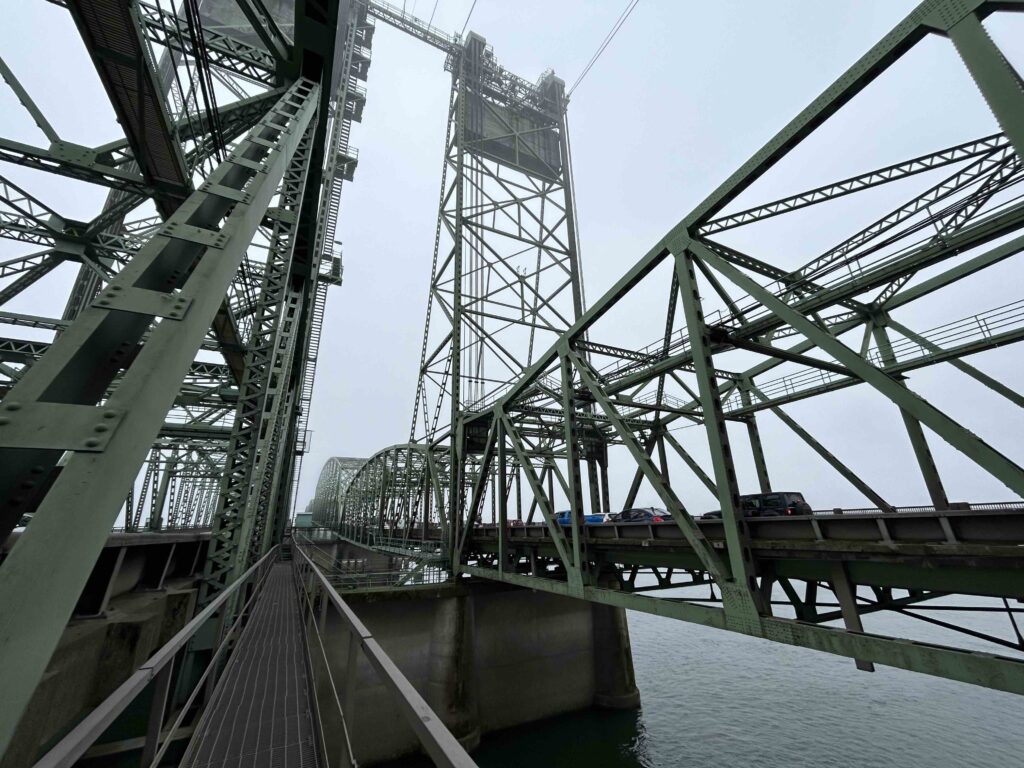More than 131,000 drivers crossed the Interstate Bridge between Portland and Vancouver each day in 2021 compared to 33,000 in 1961. (Grant Stringer/Oregon Capital Chronicle)
Fewer crashes, faster commutes, more transit options and less air pollution are among the expected benefits of replacing the Interstate 5 bridge across the Columbia River, linking Washington and Oregon, according to a new report released Friday.
There will be costs as well. Construction will require buying up as many as 43 homes and 36 businesses in the two states. Tolling to cover bridge operations will hit lower-income families hardest. And some vessels may be too tall to travel under a new span depending on the chosen design.
The report, known as the draft Supplemental Environmental Impact Statement, spans hundreds of pages. It examines potential impacts of locally preferred alternatives for a new bridge compared to doing nothing, or a “no build” option.
Its much-anticipated arrival provides some of the most specific details yet on how the massive, multi-billion undertaking will transform the region. Friday marked the start of a 60-day public comment period on its findings.
Greg Johnson, administrator of the Interstate Bridge Replacement Program, called the release of the report “a key milestone” and said a focus the next few weeks will be to get the widest ranges of voices from communities reflected in the document.
It is a lengthy and technical document. Online, it is spliced into sections on the program website, with a separate link to each topic like transportation, acquisitions or cumulative effects.
“We’ve done everything we can to bring information to the public so that they can be part of this historic, monumental endeavor,” said Chris Regan, the project’s environmental manager.
A huge challenge
One of the bridge’s two spans is over a century old, the other about 65 years old, and the entire bridge is at risk of collapse in a major earthquake
Project planners estimate the price tag for replacing the bridge will range from $5 billion to $7.5 billion, with a likely figure of around $6 billion. Once rolling, construction is expected to last until 2032.
Thus far, federal grants totaling $2.1 billion have been locked down. Planners are pursuing $1 billion from the Federal Transit Administration’s Capital Investment Program. A decision on that funding isn’t expected until the project is further along.
Washington and Oregon have both committed about $1 billion. Tolls – which could be imposed in both directions on the existing bridge by 2026 – are counted on to raise $1.2 billion for construction, plus provide an ongoing stream of revenue for bridge maintenance and operations.
What’s envisioned is construction of two new bridges, one southbound and one northbound, west of the existing bridge. Each would have three through lanes, safety shoulders, and one or two auxiliary lanes, depending on the chosen alternative. When finished, the existing bridge would be removed.
Also planned is a 1.9-mile extension of light-rail from North Portland, where it currently ends, to a future station near Evergreen Boulevard in Vancouver.
There are three bridge configurations under consideration. One is a double-deck truss bridge with vehicles using the top deck and light rail on the lower deck. Another design is for two single-level bridges with fixed spans, and the third is a single-level bridge with a movable span, similar to what exists today.
The report looks at other elements of the projects including new transit stations, new highway interchanges, tolling and impacts on land use and local economy.
Program officials said at a news conference Friday that what is learned from the review process, and environmental studies, will inform their efforts to avoid, minimize or mitigate negative effects.
Good and bad
At a high level, one of the biggest benefits cited by the report is how traveling along the I-5 corridor between Vancouver and Portland would improve.
It is anticipated that with more transit options – light rail and express buses – there will be fewer vehicles on the road. Less congestion will shorten commute times and reduce the number of crashes, the report concludes.
And the project will greatly reduce the amount of greenhouse gas emissions as drivers switch to low and carbon free transportation options, Regan said.
One negative could be the homes and businesses acquired to make way for the project.
In Washington, most acquisitions and displacements would be commercial properties and multifamily dwellings in downtown Vancouver, the report states. Some single-family residences would be acquired along I Street in Vancouver’s Shumway neighborhood and up to 13 businesses in downtown Vancouver would be displaced.
In Oregon, commercial properties and floating homes on Hayden Island will need to be bought up.
An area the project could have a “cumulative adverse effect” is navigation on the river, the report found.
If the new span is a drawbridge, the vertical clearance will be 178 feet as it is today.
But the other potential designs – single- or double-deck fixed-spans – would have only 116 feet of vertical clearance. That would “permanently prevent vessels with (vertical navigation clearance) requirements of greater than 116 feet to transit under the bridge for its 100+ year service life,” the report concludes.
The IBR Program plans six public meetings in October, four virtual and two in-person. Times and details can be found online at www.interstatebridge.org.

